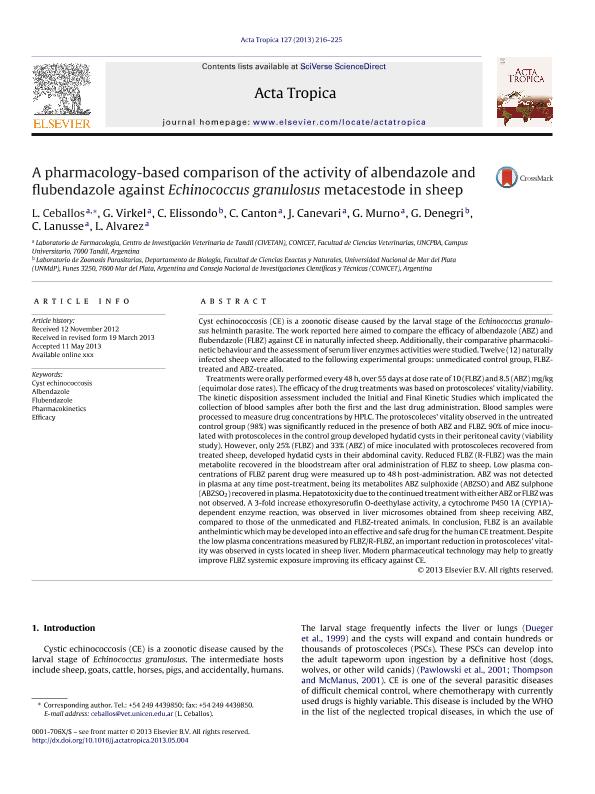Artículo
A pharmacology-based comparison of the activity of albendazole and flubendazole against Echinococcus granulosus metacestode in sheep
Ceballos, Laura ; Virkel, Guillermo Leon
; Virkel, Guillermo Leon ; Elissondo, C.; Cantón, Candela; Canevari, J.; Murno, G.; Denegri, G.; Lanusse, Carlos Edmundo
; Elissondo, C.; Cantón, Candela; Canevari, J.; Murno, G.; Denegri, G.; Lanusse, Carlos Edmundo ; Alvarez, Luis Ignacio
; Alvarez, Luis Ignacio
 ; Virkel, Guillermo Leon
; Virkel, Guillermo Leon ; Elissondo, C.; Cantón, Candela; Canevari, J.; Murno, G.; Denegri, G.; Lanusse, Carlos Edmundo
; Elissondo, C.; Cantón, Candela; Canevari, J.; Murno, G.; Denegri, G.; Lanusse, Carlos Edmundo ; Alvarez, Luis Ignacio
; Alvarez, Luis Ignacio
Fecha de publicación:
11/2013
Editorial:
Elsevier Science
Revista:
Acta Tropica
ISSN:
0001-706X
Idioma:
Inglés
Tipo de recurso:
Artículo publicado
Clasificación temática:
Resumen
Cyst echinococcosis (CE) is a zoonotic disease caused by the larval stage of the Echinococcus granulosus helminth parasite. The work reported here aimed to compare the efficacy of albendazole (ABZ) and flubendazole (FLBZ) against CE in naturally infected sheep. Additionally, their comparative pharmacokinetic behaviour and the assessment of serum liver enzymes activities were studied. Twelve (12) naturally infected sheep were allocated to the following experimental groups: unmedicated control group, FLBZ-treated and ABZ-treated.
Treatments were orally performed every 48 h, over 55 days at dose rate of 10 (FLBZ) and 8.5 (ABZ) mg/kg (equimolar dose rates). The efficacy of the drug treatments was based on protoscoleces’ vitality/viability. The kinetic disposition assessment included the Initial and Final Kinetic Studies which implicated the collection of blood samples after both the first and the last drug administration. Blood samples were processed to measure drug concentrations by HPLC. The protoscoleces’ vitality observed in the untreated control group (98%) was significantly reduced in the presence of both ABZ and FLBZ. 90% of mice inoculated with protoscoleces in the control group developed hydatid cysts in their peritoneal cavity (viability study). However, only 25% (FLBZ) and 33% (ABZ) of mice inoculated with protoscoleces recovered from treated sheep, developed hydatid cysts in their abdominal cavity. Reduced FLBZ (R-FLBZ) was the main metabolite recovered in the bloodstream after oral administration of FLBZ to sheep. Low plasma concentrations of FLBZ parent drug were measured up to 48 h post-administration. ABZ was not detected in plasma at any time post-treatment, being its metabolites ABZ sulphoxide (ABZSO) and ABZ sulphone (ABZSO2) recovered in plasma. Hepatotoxicity due to the continued treatment with either ABZ or FLBZ was not observed. A 3-fold increase ethoxyresorufin O-deethylase activity, a cytochrome P450 1A (CYP1A)-dependent enzyme reaction, was observed in liver microsomes obtained from sheep receiving ABZ, compared to those of the unmedicated and FLBZ-treated animals. In conclusion, FLBZ is an available anthelmintic which may be developed into an effective and safe drug for the human CE treatment. Despite the low plasma concentrations measured by FLBZ/R-FLBZ, an important reduction in protoscoleces’ vitality was observed in cysts located in sheep liver. Modern pharmaceutical technology may help to greatly improve FLBZ systemic exposure improving its efficacy against CE.
Palabras clave:
Cyst Echinococcosis
,
Albendazole
,
Flubendazole
,
Pharmacokinetics/Efficacy
Archivos asociados
Licencia
Identificadores
Colecciones
Articulos(CIVETAN)
Articulos de CENTRO DE INVESTIGACION VETERINARIA DE TANDIL
Articulos de CENTRO DE INVESTIGACION VETERINARIA DE TANDIL
Citación
Ceballos, Laura; Virkel, Guillermo Leon; Elissondo, C.; Cantón, Candela; Canevari, J.; et al.; A pharmacology-based comparison of the activity of albendazole and flubendazole against Echinococcus granulosus metacestode in sheep; Elsevier Science; Acta Tropica; 127; 3; 11-2013; 216-225
Compartir
Altmétricas



